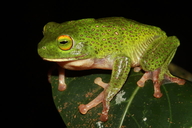|
Pseudophilautus stellatus (Kelaart, 1853)
| family: Rhacophoridae subfamily: Rhacophorinae genus: Pseudophilautus |
|
Taxonomic Notes: Recently rediscovered and affirmed as a distinct taxon by Wickramasinghe and colleagues (Zootaxa 3620:112-128). Its status should be changed from Extinct to Critically Endangered. |
|
 © 2013 L. J. Mendis Wickramasinghe (1 of 2) |
|
|
|
Description Distribution and Habitat Country distribution from AmphibiaWeb's database: Sri Lanka
Larva Trends and Threats Possible reasons for amphibian decline General habitat alteration and loss Comments This species was described as Polypedates stellata by Kelaart (1853), who diagnosed the genus as having large discs and incomplete webbing. Bossuyt anbd Dubois (2001) point out that the combination of characters places this species as a member of the current subfamily Rhacophorinae. No known Sri Lankan Polypedates is green, but some Sri Lankan Pseudophilautus and Kirtixalus are green or greenish (Bossuyt and Dubois 2001). The SVL of 57 mm described by Kelaart (1853) is larger than any known Sri Lankan Pseudophilautus, although several Sri Lankan Kirtixalus reach or exceed that size, leading Bossuyt and Dubois (2001) to propose that this species is actually a member of the genus Kirtixalus. Bossuyt and Dubois (2001) also suggested that since many new Sri Lankan species of Kirtixalus remain to be described, the name Pseudophilautus stellatus should be used to describe another species from the Nuwara Eliya area, with characters matching those of Kelaart's (1853) description, and that a neotype be collected. Since the holotype cannot be found, Manamendra and Pethiyagoda (2005) have instead put forward that Pseudophilautus stellatus should be considered a valid species name, and that another name be used for any similar species. Known only from the lost holotype, Pseudophilautus stellatus had not been recorded since its description (Kelaart 1853) despite extensive searches for over 150 years and was presumed extinct (Stuart et al. 2008). In 2013, L.J. Mendis Wickramasinghe and colleagues announced its rediscovery nearly 160 years later; these striking individuals were found in inaccessible, high elevation cloud forests in the Peak Wilderness of Sripada World Heritage Site. Despite being found in a protected area, the area is suffering from forest dieback, expanding tea plantations, illegal mining and the expansion of invasive species, so it continued survival is not assured. The study recommends listing the species as "Critically Endangered" (Wickramasinghe et al 2013).
References
Bossuyt, F., and Dubois, A. (2001). ''A review of the frog genus Philautus Gistel, 1848 (Amphibia, Anura, Ranidae, Rhacophorinae).'' Zeylanica, 6, 1-112. Kelaart, E. F. (1853). Prodromus Faunae Zeylanicae: being Contributions to the Zoology of Ceylon. Self-published by E. F. Kelaart, Colombo. Manamendra-Arachchi, K., and Pethiyagoda, R. (2005). ''The Sri Lankan shrub-frogs of the genus Philautus Gistel, 1848 (Ranidae: Rhacophorinae), with description of 27 new species.'' Raffles Bulletin of Zoology, Supplement 12, 163-303. Stuart, S., Hoffmann, M., Chanson, J., Cox, N., Berridge, R., Ramani, P., Young, B. (eds) (2008). Threatened Amphibians of the World. Lynx Edicions, IUCN, and Conservation International, Barcelona, Spain; Gland, Switzerland; and Arlington, Virginia, USA. Wickramasinghe, L. J. M., Vidanapathirana, D.R., Airyarathne, S., Rajeev, G., Chanaka, A., Pastorini, J., Chathuranga, G., And Wickramasinghe, N. (2013). ''Lost and found: One of the world's most elusive amphibians, Pseudophilautus stellatus (Kelaart 1853) rediscovered.'' Zootaxa, 3620(1), 112-128. Originally submitted by: Krystal Gong (first posted 2009-04-13) Edited by: Kellie Whittaker, Michelle S. Koo (2022-08-18) Species Account Citation: AmphibiaWeb 2022 Pseudophilautus stellatus <https://amphibiaweb.org/species/6077> University of California, Berkeley, CA, USA. Accessed Jan 27, 2025.
Feedback or comments about this page.
Citation: AmphibiaWeb. 2025. <https://amphibiaweb.org> University of California, Berkeley, CA, USA. Accessed 27 Jan 2025. AmphibiaWeb's policy on data use. |


 Map of Life
Map of Life